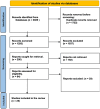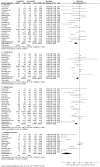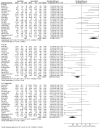Analyzing and evaluating the prevalence and metabolic profile of lean NAFLD compared to obese NAFLD: a systemic review and meta-analysis
- PMID: 39234426
- PMCID: PMC11372778
- DOI: 10.1177/20420188241274310
Analyzing and evaluating the prevalence and metabolic profile of lean NAFLD compared to obese NAFLD: a systemic review and meta-analysis
Abstract
Background: Non-alcoholic fatty liver disease (NAFLD) is a common liver condition affecting 25%-40% of the worldwide population. NAFLD is traditionally related to obesity and metabolic disorders. NAFLD can also affect non-obese individuals, termed "lean NAFLD" (LN), who exhibit a paradoxical combination of physical leanness and metabolic obesity. Factors contributing to LN remain unclear, necessitating further research. This analysis aims to understand LN's prevalence and metabolic characteristics compared to obese NAFLD (ON) populations.
Methods: This meta-analysis searched various databases until August 1, 2023. Inclusion criteria involved observational studies comparing LN with overweight/obese NAFLD. Data extraction included baseline characteristics, disease occurrence, metabolic profile, and clinical parameters-statistical analysis employed calculating risk ratios (RR) and standard mean differences.
Results: Twenty-five studies were analyzed. LN is associated with lower prevalence in both NAFLD (RR 0.27, 95% confidence interval (CI) 0.14-0.52, p = <0.0001) and total (RR 0.27, 95% CI 0.15-0.51, p < 0.0001) population. LN had lower diabetes mellitus (RR 0.78, 95% CI 0.71-0.87, p < 0.00001), dyslipidemia (RR 0.87, 95% CI 0.79-0.95, p = 0.002), hypertension (RR 0.80, 95% CI 0.74-0.87, p < 0.00001), and metabolic syndrome (RR 0.45, 95% CI 0.31-0.64, p < 0.00001) compared to those with ON. The LN group's lipid profile, blood pressure, and other clinical parameters were favorable compared to ON.
Conclusion: The prevalence of NAFLD among lean and non-lean individuals varies by region. Our analysis revealed that LN is associated with lower metabolic diseases, fasting blood sugar, blood pressure, and a more favorable lipid profile compared to ON.
Keywords: NAFLD; lean NAFLD; metabolic profile; prevalence.
Plain language summary
NAFLD prevalence and its characteristics among obese vs lean population Non-alcoholic fatty Liver Disease (NAFLD) is a prevalent liver condition affecting a substantial portion of the global population, commonly linked to obesity and metabolic disorders. However, a subset of individuals with NAFLD, termed “lean NAFLD” (LN), challenges the conventional association by presenting with physical leanness despite metabolic obesity. The factors contributing to this condition are not well understood, prompting this meta-analysis to explore the prevalence and metabolic characteristics of LN compared to obese NAFLD (ON) populations. The study, conducted through August 1st, 2023, analyzed 25 studies meeting inclusion criteria, which involved observational studies comparing LN with Overweight/Obese NAFLD. Data extraction included baseline characteristics, disease occurrence, metabolic profiles, and clinical parameters. Statistical analysis utilized risk ratios (RR) and standard mean differences. The results indicated that LN is associated with a significantly lower prevalence in both the NAFLD and general populations. LN demonstrated lower occurrences of diabetes (DM), dyslipidemia, hypertension, and metabolic syndrome compared to ON. Additionally, the LN group exhibited a more favorable lipid profile, blood pressure, and other clinical parameters in comparison to the ON group. In conclusion, the prevalence of NAFLD varies among lean and non-lean individuals across different regions. The meta-analysis revealed that LN is linked to a lower occurrence of metabolic diseases, lower fasting blood sugar levels, lower blood pressure, and a more favorable lipid profile compared to those with ON. These findings contribute valuable insights into the distinct metabolic characteristics of LN, shedding light on potential avenues for further research and clinical considerations in the understanding and management of NAFLD.
© The Author(s), 2024.
Figures








Similar articles
-
Lean-non-alcoholic fatty liver disease increases risk for metabolic disorders in a normal weight Chinese population.World J Gastroenterol. 2014 Dec 21;20(47):17932-40. doi: 10.3748/wjg.v20.i47.17932. World J Gastroenterol. 2014. PMID: 25548491 Free PMC article.
-
Clinical Characteristics and Metabolic Profiles of Non-Alcoholic Fatty Liver Disease (NAFLD) in Lean Patients and Their Comparison with Obese and Overweight NAFLD.J Assoc Physicians India. 2022 Apr;70(4):11-12. J Assoc Physicians India. 2022. PMID: 35443531
-
Global prevalence, incidence, and outcomes of non-obese or lean non-alcoholic fatty liver disease: a systematic review and meta-analysis.Lancet Gastroenterol Hepatol. 2020 Aug;5(8):739-752. doi: 10.1016/S2468-1253(20)30077-7. Epub 2020 May 12. Lancet Gastroenterol Hepatol. 2020. PMID: 32413340
-
Global epidemiology of lean non-alcoholic fatty liver disease: A systematic review and meta-analysis.J Gastroenterol Hepatol. 2020 Dec;35(12):2041-2050. doi: 10.1111/jgh.15156. Epub 2020 Jul 7. J Gastroenterol Hepatol. 2020. PMID: 32573017
-
Study and Comparison of Metabolic Profile of Lean and Obese Subjects with Non Alcoholic Fatty Liver Disease.J Assoc Physicians India. 2020 Aug;68(8):51-54. J Assoc Physicians India. 2020. PMID: 32738842
Cited by
-
Targeted Sodium Acetate Liposomes for Hepatocytes and Kupffer Cells: An Oral Dual-Targeted Therapeutic Approach for Non-Alcoholic Fatty Liver Disease Alleviation.Nutrients. 2025 Mar 6;17(5):930. doi: 10.3390/nu17050930. Nutrients. 2025. PMID: 40077800 Free PMC article.
References
-
- Muthiah MD, Cheng Han N, Sanyal AJ. A clinical overview of non-alcoholic fatty liver disease: a guide to diagnosis, the clinical features, and complications—what the non-specialist needs to know. Diabetes Obes Metab 2022; 24(Suppl. 2): 3–14. - PubMed
LinkOut - more resources
Full Text Sources
Miscellaneous

